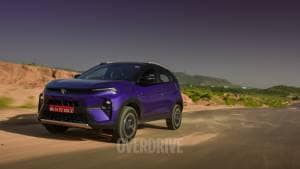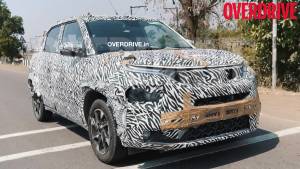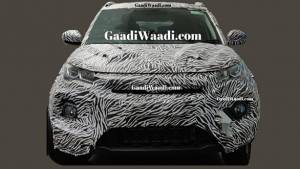2017 Tata Nexon first drive review: Can the Nexon take the fight to the Maruti Suzuki Vitara Brezza?
Looks
Smashing! The Tata Nexon is one car that has stayed true to its concept roots. Everything including the stance and overall design language can be related to the concept. In fact, a few people in and around Kochi asked us if this is a prototype car that we're driving around. The Impact Design, as Tata likes to call it, has been working quite well with all of its recent launches like the Tiago, Tigor and Hexa. The black honeycomb grille is a nice element with a chrome outline to it, flanked by the tear drop projector headlamps. These lights have a LED strip that doubles up as a DRL. Unlike the Brezza's units, these cannot be switched off. The air intake too is large and above it, pushed to the sides are eyebrow-shaped enclosures that house the fog lamps. The lower part of this nacelle is a white ceramic sash which does its job quite well in bringing your attention to the car.
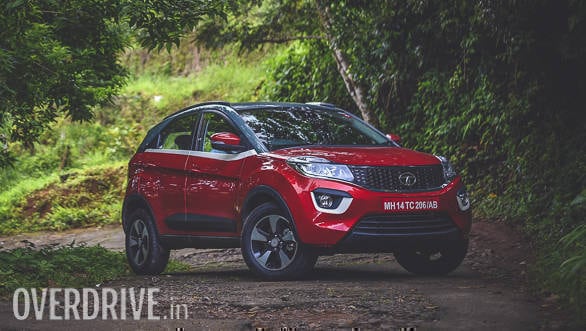
Moving on to the side, the coupe-like roofline looks really cool. The ceramic sash used for the fog lamps too has been used here for the rising belt line. The wheel arches aren't unusually flared but house 16-inch wheels as standard. Tata Motors' designers have used a bluish grey colour for the Elite i20-like floating roof. At the rear, the pinched lines create a harmonious effect to portray what will be one of the most attractive derrieres on any Indian car. The lower part of the bumper has a black diffuser, which is also shared with the Tiago and its derivatives.

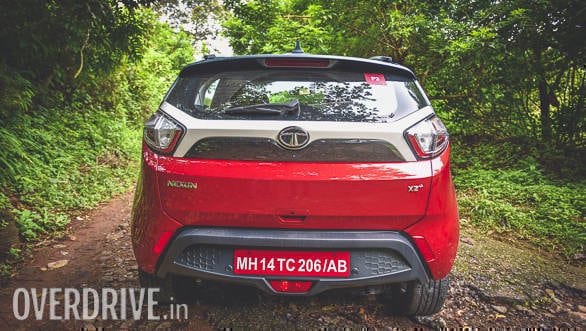
If only looks could sell, the Nexon will be a top seller. However, the Nexon doesn't look like a true-blue SUV and instead feels like a hatchback on stilts. Remember the Vista D90 Xtreme concept?
Interior
Open the door and you will be welcomed by a familiar layout that we've seen in recent Tata cars. The steering wheel, for example, is the same from the Zest from 2014. The meters too are shared with the Tiago. Manufacturers generally tend to share parts with their other offerings to ease the cost of operations. Move aside from this and you will notice the all-new floating 6.5-inch HD touchscreen infotainment system. It is a vivid unit, easy to use and supports Bluetooth and Android Auto. Apple CarPlay integration will be done at a later stage. It isn't retractable though. Asking for too much, aren't we? The dashboard layout includes the premium-feeling line that runs through its length. The quality of materials used on the upper part of the dashboard though aren't as premium. Most of the buttons are centred around the dashboard and are easy to use and understand. The cooled glovebox is large and has a tray to carry around iPads and tablets. It can be removed to liberate more space to carry a soft drink can. Tata has also added height adjustable seat belts for the front occupants.
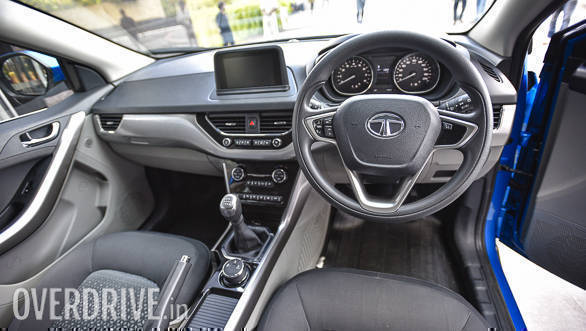 The inside of the car could have been a tad better executed. The dashboard by itself isn't as bad looking, but there are a few elements that could have been better like plastics at some places
The inside of the car could have been a tad better executed. The dashboard by itself isn't as bad looking, but there are a few elements that could have been better like plastics at some places
The rear passengers will feel comfortable with twin AC vents and a two-blower speed control. The boot space is pegged at 350 litres; however, the 60:40 rear split seats ensure that this capacity can be increased to an impressive 690 litres. The boot also gets a light and the loading lip too is low and hence fitting in two small suitcases doesn't look like a problem.
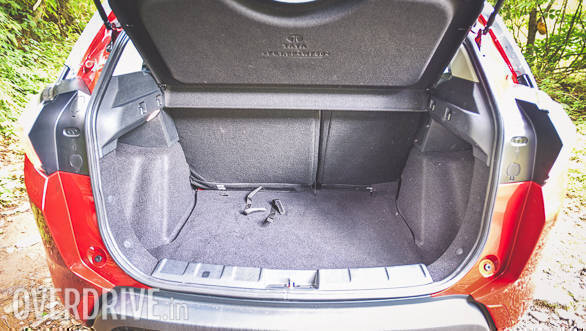 The boot space is 350 litres and can be increased to 690 litres with the help of the 60:40 split rear seats
The boot space is 350 litres and can be increased to 690 litres with the help of the 60:40 split rear seats
Fit and finish, a Tata bugbear, though hasn't really improved from the other offerings by the manufacturer.
Features
There are many firsts for a Tata car and for the segment as well. While it isn't clear yet if this will be offered as an accessory or as standard, Tata Motors showed us a wristband watch. This wristband eliminates the need to carry the key fob to places like the gym or at a party. Simply wear the band and press the door unlock request sensor. This band though temporarily disables the key fob. It is done to ensure that a second person cannot request entry into the car with the key fob or a duplicate.
 This looks like a health band. It isn't though. It uses RF to replace the key. Suppose you're going to the gym and do not want to carry the key. Use this specifically designed band and lock and unlock the car by touching the door sensor. The boot too can be opened with this. However, till the time you are using this band, the main key will be rendered obsolete
This looks like a health band. It isn't though. It uses RF to replace the key. Suppose you're going to the gym and do not want to carry the key. Use this specifically designed band and lock and unlock the car by touching the door sensor. The boot too can be opened with this. However, till the time you are using this band, the main key will be rendered obsolete
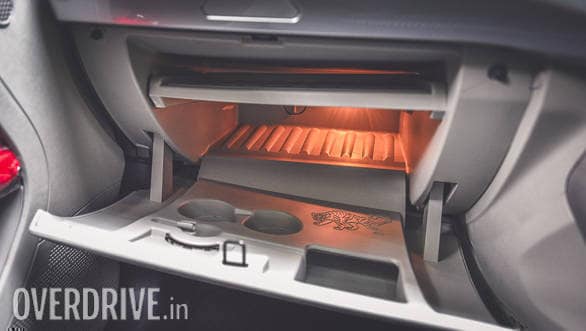 That glove box is big enough to hold a laptop (notice a separate compartment for it and is illuminated too). The tray can be removed to increase the storage capacity. The glovebox is cooled too
That glove box is big enough to hold a laptop (notice a separate compartment for it and is illuminated too). The tray can be removed to increase the storage capacity. The glovebox is cooled too
Other all-new features include door lock-unlock sensors on both the front doors and boot, a new key fob with remote boot unlock function, the infotainment system we discussed earlier, sliding cover mechanism for the storage space next to the handbrake, slots to hold umbrellas in the front doors, Drive mode rotary dial, and a parking aid that switches on the reverse parking camera even when the reverse gear isn't engaged. This is apart from the automatic climate control, electrically folding mirrors, front and rear fog lamps, parcel hooks near the front and rear seats, sunglass holder, central armrest at the front and back that can also hold two cups as well as the door pockets at the front and back that will accommodate your half-litre bottles.
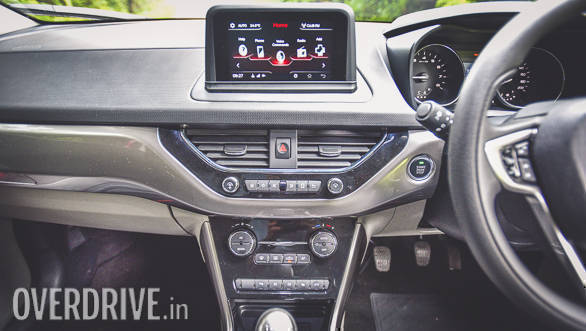 This new 6.5-inch floating touchscreen is the centre-piece of the Nexon's cabin. It is compatible with Android Auto as of now, but Apple CarPlay will be added at a later stage. The screen is vivid and doesn't have lag. A good sign, then!
This new 6.5-inch floating touchscreen is the centre-piece of the Nexon's cabin. It is compatible with Android Auto as of now, but Apple CarPlay will be added at a later stage. The screen is vivid and doesn't have lag. A good sign, then!
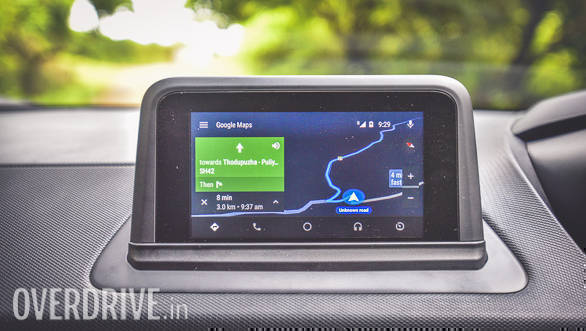
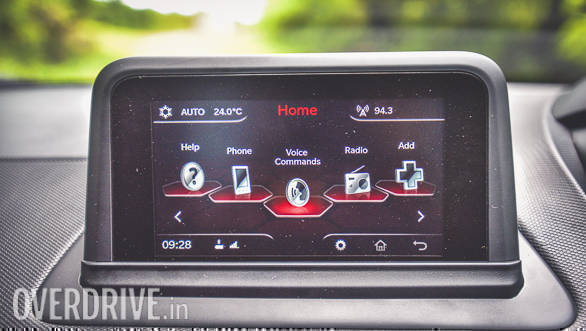 Looks a bit Jaguar inspired, doesn't it? Well, Tata owns JLR
Looks a bit Jaguar inspired, doesn't it? Well, Tata owns JLR
What clearly should have been added are automatic headlights as well as wipers. Speaking of which, the wiper blade doesn't fully clean the glass surface near the driver. This doesn't hamper vision but nevertheless could have been executed in a better fashion or by using a larger wiper blade. The sunglass holder is lined with a soft material inside; however, the access to the slot itself is a bit awkward -- it didn't accommodate my aviators. The USB slot right ahead of the gear lever is too deep and isn't really the most ergonomic when it comes to usage. Also the headlamp levelling switch is placed on the stalk, making it a bit inconvenient while changing the beam on the move.
Ride and handling
The new Tata Nexon is one spacious car. It is based on the X1 platform, a heavily modified iteration of the one used for the Zest and Bolt. I personally had a reservation that the rear seat may not be as comfortable because of the coupe-like roof and all, but I really shouldn't have bothered. Imagine this plot. The driver's seat is set to my position and Anis is sitting behind as is evident from the image. Mind you, Anis is no pygmy and is nearly 5ft 7in tall. He has enough legroom and headroom. Even when I sit in the rear seat, the headroom isn't that bad and I actually have about three-finger length of space left between my hair and the roof. Impressive! The front seats though are wafer thin and don't provide enough support. The seat squab at the back is decent and there is plenty of under-thigh support as well.
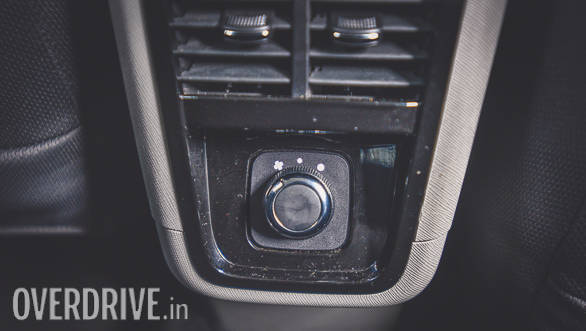 There are two rear AC vents with two blower speeds controlling them
There are two rear AC vents with two blower speeds controlling them
 The sloping roofline doesn't eat space at the back. In fact, the packaging is very clever and Tata has used thin foam for the seats to liberate more space inside the cabin. Here is 5ft-7inch-tall Anis sitting behind the driver's seat set for a 6ft-plus driver. The under-thigh support too is decent
The sloping roofline doesn't eat space at the back. In fact, the packaging is very clever and Tata has used thin foam for the seats to liberate more space inside the cabin. Here is 5ft-7inch-tall Anis sitting behind the driver's seat set for a 6ft-plus driver. The under-thigh support too is decent
The first time we encountered a pothole on the narrow but superbly surfaced road leading to Idukki, the car felt like it was just using a rubber foam. The suspension just smothers everything in its path. There is some amount of lateral movement when you go into a pothole; however, the suspensions caresses your back and tells you that it has done its job. All this happens without the usual thuds that you associate dampers with. In fact, the tracking car, Innova, had to slow down for the road imperfections while we just blazed past them all. The 209mm ground clearance too is a boon in these situations; however, the Nexon still is a front-wheel-drive car and is unlikely to be offered with an AWD or 4-wheel drive in the future. So going into the rough might take some planning.
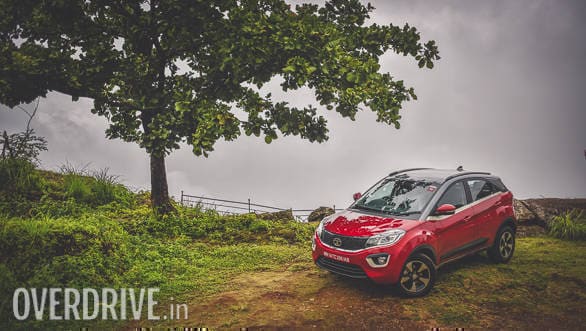
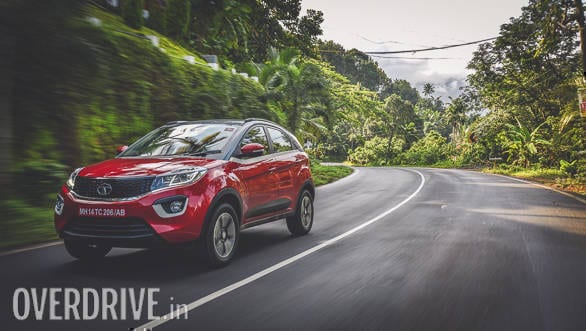
On the handling front, the Nexon SUV feels no different to, let's say, the Tiago or Tigor. It feels predictable around bends but carry too much speed and there is evident body roll. So it's safe to say that the Nexon will take the corners decently but will not be a corner carver or anywhere near the Brezza when it comes to handling. The brakes though deserve a special mention here. The front disc and rear drum set up of the Nexon along with all-new high-quality brake pads ensure that the SUV stops predictably and with plenty of feedback through the pedal. They are sharp but in a progressive fashion. ABS and dual airbags too are standard across the range.
Engines and performance
Tata is offering all-new petrol and diesel engines in the Nexon. Both can be upgraded to BS-VI norms as and when the mandate comes in. While the basic architecture of the 1.2-litre indirect injection turbo-petrol engine is the same as the Tiago's 3-cylinder motor, Tata says that they have used all the know-how from the Zest's turbopetrol unit and incorporated it here. So while the block remains the same, the engine is lighter than the Zest's turbocharged unit and also makes 110PS of power and 170Nm of torque. These figures in the compact SUV segment are lower than that of only the EcoSport's 125PS turbo-petrol engine.
The diesel, in the meanwhile, is a 1.5-litre unit that makes the same amount of power as the petrol but a significantly higher 260Nm of torque. Both the engines are mated to 6-speed manual transmissions, with AMTs to be slotted in at a later date. Tata also offers the aforementioned Drive modes in both the variants. The Drive modes can be accessed via the rotary knob and can be changed on the move. The good part about this dial is that whatever mode you've selected, there will be an audio note telling you the selection and the colour of the infotainment system too changes a la Mini Cooper style. The dial also remembers the last selection made and sticks to it even after the car has been switched off.
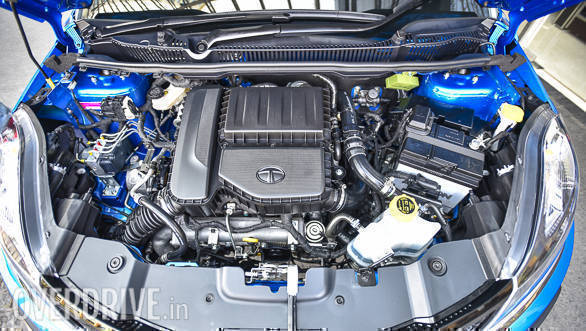 The 110PS/260Nm 4-cylinder diesel motor is good for cruising and is claimed to deliver a higher fuel efficiency than the Brezza
The 110PS/260Nm 4-cylinder diesel motor is good for cruising and is claimed to deliver a higher fuel efficiency than the Brezza
We had a go at the turbopetrol engine first. At start-up, the engine has decent refinement; however, on the move, it is audible. There is some amount of turbolag and the motor isn't that happy sitting at high revs. What it is happy doing is cruising. At around 1,600rpm, the engine is doing 100 clicks in top gear. Good for those efficiency numbers then. It is also tractable and even at a higher gear and low revs, the engine is happy. For example 40kmph in fourth gear is possible and the engine doesn't really protest. But if you want quick acceleration, you need to drop a couple of gears before making any progress. The hairpins up Idukki dam were taken in second gear; however, the moment brisk acceleration was called for uphill, I had to downshift. Rowing through the gears though is pretty much fun as the gearbox is slick. Vibrations are present though and manifest through the pedals and gear lever. However, they aren't at an alarming level.
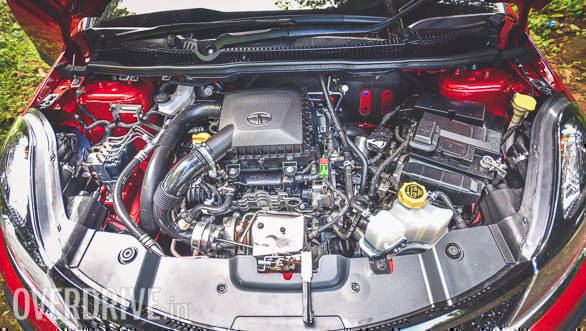 The new 1.2-litre 3-cylinder turbo-petrol engine isn't the same one used in the Zest. It is lighter and also makes 20PS more. The torque rating is 170Nm
The new 1.2-litre 3-cylinder turbo-petrol engine isn't the same one used in the Zest. It is lighter and also makes 20PS more. The torque rating is 170Nm
The diesel, in the meanwhile, sounds as refined as the Brezza's unit. It, however, is the punchier of the two motors. The clutch is light and has a short travel while the gearshift too is smooth. Surprisingly, the diesel is a bit more eager to rev than the petrol. Tractability remains common for both with the exception that hurried progress doesn't really require dropping a gear in the diesel. This will be the engine to watch out amongst the two. It has less turbolag and gets the job done in a better fashion.
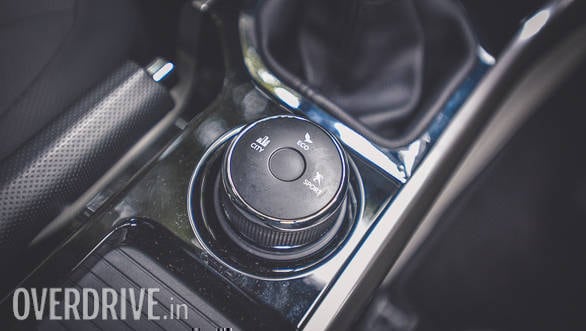 This knob replaces the earlier button system that allowed one to select the Drive modes. It is easy to use and can be used on the move. Plus you get an audio reminder of the mode you've selected, and the mode stays on till you manually change it. This stays good even after the car is switched off
This knob replaces the earlier button system that allowed one to select the Drive modes. It is easy to use and can be used on the move. Plus you get an audio reminder of the mode you've selected, and the mode stays on till you manually change it. This stays good even after the car is switched off
The Drive modes do alter the engine mapping and throttle setting, but over the years Tata Motors has refined it. The Sport mode no longer feels snappy. Instead it is quite linear. Around 70 per cent of our first drive review was done in this mode. City is the apt one for err in the city while Eco dulls out the throttle response and requires a bit more of patience when hurried progress is to be made.
Conclusion
The Tata Nexon is a very good effort from the manufacturer. It is sub-4m, has the good looks to boost its sales, space inside the cabin is good too and the engines also deliver decent performance. Knowing Tata's pricing strategy, expect the Nexon petrol to start from Rs 6.5 lakh with the top-spec diesel will be priced just shy of Rs 10 lakh. At this point, it will undercut its biggest rival, the Maruti Suzuki Vitara Brezza, by a good Rs 50,000. Plus the Brezza still doesn't come with a petrol engine.
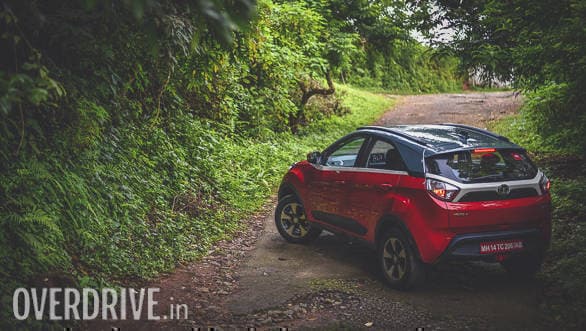
Tata Motors will launch the Nexon in India this September. The company says that they have already started taking bookings and by the time the car actually goes on sale, most of the small issues we mentioned in this review will be ironed out. Back to our question then. Will the Nexon be the next one? It will be for Tata Motors but maybe the Brezza is safe at its position for now.
Images by Anis Shaikh
Also Read:
Tata Nexon image gallery
Starts Rs 6.95 Lakhs
1497cc
Automatic
110
260
21.5 Kmpl
Starts Rs 7.99 Lakhs
1498cc
Manual
100
215
21.7 Kmpl
Starts Rs 38 Lakhs
1998cc
Automatic
231
320
15.81 Kmpl
